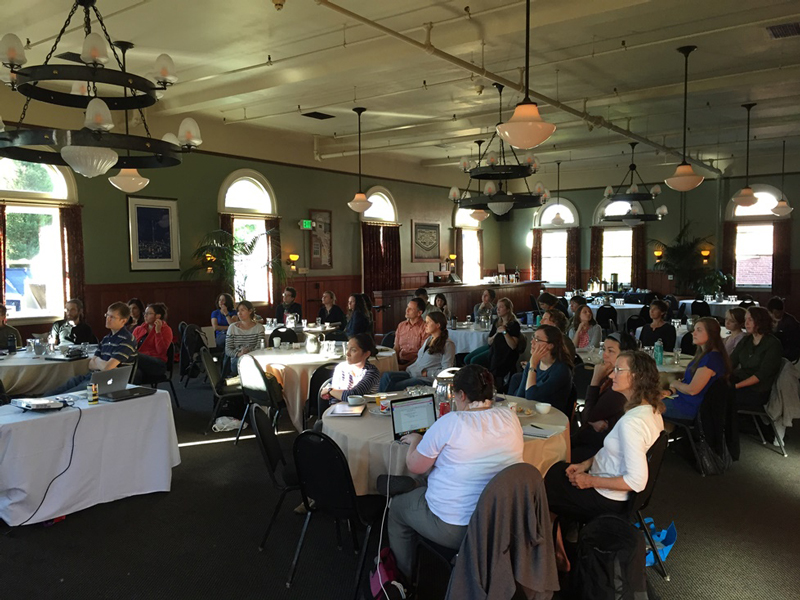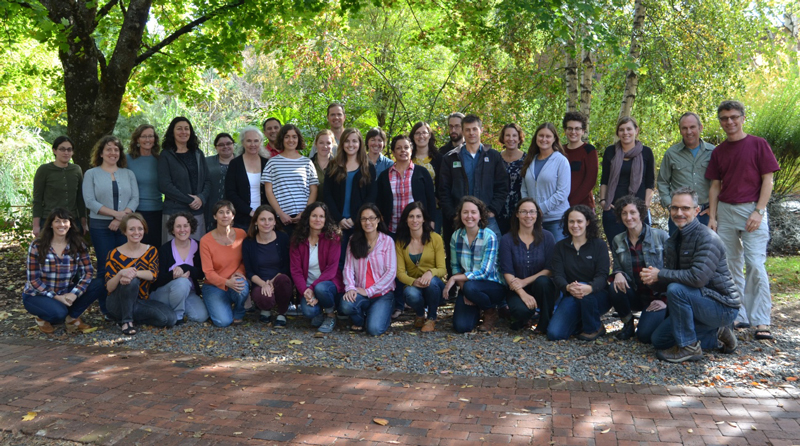Xerces staff now includes 40 individuals working all over the country. Once a year staff come together to share and reflect upon the work we're doing and chart a course for what's next.
One of the most striking things about our recent staff retreat was the number of people in the room — indeed, the size of the room we needed. We now have 40 people on staff. Looking back to when I first started working at Xerces, when there was a staff of four, this seems an almost improbable number. I’ve worked for the Xerces Society for longer than anyone else on the staff — just over 16 years — and remember previous retreats that could be held around a dining room table or sitting in a circle in a living room. This year we needed a ballroom!
More profound, though, was the incredible depth of knowledge and experience that was in the room: entomologists, plant ecologists, restoration ecologists, conservation biologists — a lot of “ists”! — not to forget the administrative, fundraising, and membership staff without whom Xerces could not run so efficiently and who enable our science and conservation staff to work so effectively.

Part of Xerces’ strength comes from our ability to collectively reflect on what we’ve done and plan for the future. Our annual retreat is an essential part of this reflection process. It’s the one occasion each year when we all gather, turn off the notification alerts on our phones, and focus on what we’ve done, how we did it, and what more we can do. It also enables us to relax together and catch our breath, a brief pause from the constant motion of other weeks.
During the retreat we reviewed our recent accomplishments. History is being made by seven species of yellow-faced bees from Hawaii gaining protection under the Endangered Species Act; these are the first bees to be listed. Hopefully (also sadly), they will soon be joined by the rusty patched bumble bee. Our staff are also taking a lead role in conserving bumble bees worldwide through the IUCN’s Bumble Bee Specialist Group.
Habitat is essential for all insects, rare or not, and our conservation staff have worked to increase the amount and quality of habitat in all landscapes. With staff based in ten states, we can work directly with land managers, farmers, and gardeners across the country to plan, create, or protect habitat — tens of thousands of acres every year. Much of this includes milkweed, the essential host plant for monarch butterflies. We’ve also worked with agencies to modify management plans to benefit other at-risk butterflies and identify essential habitat for a range of other species such as stoneflies, as well as rescued freshwater mussels. In addition, we reached ten thousand people through bee-safe farming short courses, conferences, and other events since the last retreat, and have launched a series of short courses on conservation biocontrol.
We’ve also enjoyed success in pesticide reductions. We have worked with local communities to establish pesticide bans or restrictions in a dozen cities and counties. This work is the result of us employing a pesticide specialist, a decision taken two retreats ago. Good things do come from retreats!
All four citizen science initiatives have been doing well. The Migratory Dragonfly Partnership’s Pond Watch project has seen a great growth in participants which has led to an almost 50% increase in dragonfly records being submitted. The new Dragonfly ID app should increase that further. Bumble Bee Watch has also grown dramatically, with more than 8,000 records submitted, including of rare species and, more worryingly, of a potentially invasive species well outside its natural range. The Western Monarch Thanksgiving Count has launched a new website and been able to recruit more volunteers and monitor more monarch overwintering sites in California. We also have a program gathering data on the presence of milkweeds and breeding monarchs across western North America.
There were many other successes to share. Listening to the discussions during the retreat, I found it quite amazing how much had been achieved and how far the Society’s influence has spread since I first walked through the front door in 1999. I may not be working here in another 16 years (retirement may beckon before then) but I certainly expect the Xerces Society and its list of achievements to still be growing.




